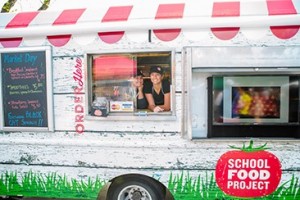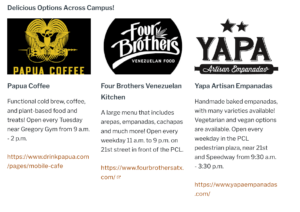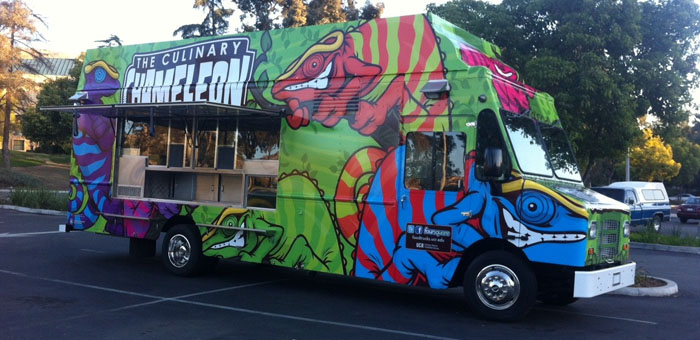Who would have thought that food trucks would find a niche in so many unexpected places, including high school and college campuses?
“Food trucks are a great addition to school food service—both from a way to engage the older kids and a way to engage the community,” says Ann Cooper, the director of food services at Colorado’s Boulder Valley School District. “It’s part of a great overall marketing strategy.”
It’s not just Colorado — school districts and universities across the nation have become Ground Zero for the food truck revolution that has taken the country by storm. It’s not too hard to understand why K-12 schools, high schools and colleges are welcoming food trucks. Kids and young adults seem to be naturally drawn to these rolling food servers. Ms. Cooper exclaims: “It’s meeting the kids where they are to provide a cool environment. There’s a different vibe to it, with music playing.”
Food trucks, whether owned independently or by the school district, are indeed cool, but they also have the potential for enhanced nutrition and financial profits. In 2014, Boulder Valley was one of the first school districts in the country to begin serving school lunches from a food truck. The brightly painted, music-blaring truck was financed by Whole Foods Market, which coughed up a $75,000 grant to pay for the district’s truck purchase. The truck rotates among different schools throughout the week. Now, schools everywhere are scrambling to attract, or buy, food trucks.
Education System Food Trucks Are Changing The Industry
A Healthful, Tasty Alternative
Food trucks are a big hit with students and with schools, for a variety of reasons, and nutrition is a very important one. Cafeterias at public schools and high schools, even those with the best intentions, must perennially contend with tight budgets on the one hand and pressure to offer healthful fare on the other. Soggy carrots and mystery meats just don’t cut it anymore (if they ever did). Boulder Valley was saddled 85 percent of teens rejecting school lunches. But food trucks have the incentive to use recipes that are stealthily healthful – to meet the concerns of the educational institutions – and delicious, to keep the trucks in business.
The Minneapolis School District’s director of food services, Bertrand Weber, worked with local restaurants to create engaging dishes, such as bowls of orange chicken or carnitas, for its food truck. According to Weber, “In just the first three weeks of this school year alone, we served 28,000 pounds of local produce. I worked with a small local turkey farmer and a turkey burger and hot dog—and found a processor to do this. We’re working next on a breakfast sausage.”

School Food Project.
Says Timothy Heneks, 21, a senior at the University of Florida, “The best things about [school food truck] La Lola Loca are the festive atmosphere it creates and the taco-dilla — it’s delicious!” Similar trucks have become fixtures at many universities, including Baylor and the University of Alabama. Lizzie’s Curbside Cuisine has been serving hungry students at the University of Connecticut for 22 years, according to owner Lizanne Searing.
“It is quick and easy to get a bite between classes,” Heneks said. “I hope [the truck] becomes a well-guarded secret to those who love it. That would keep the lines short.”
Helping the Farmers
The USDA’s Farm to School program embraces the food truck craze as an outlet for fresh, healthy produce, as opposed to the manufactured grey and brown food served in many school cafeterias. Sometimes it’s a tough sell, especially to kids who have grown up on junk food, but well worth the effort.
The USDA estimates that more than 23 million children have access to food supplied by the Farm to School program. Local farms sell food worth almost $400 million each year to schoolchildren.
The director of the Farm-to-School program, Deborah Kane, is excited at the prospects for food trucks at schools. “They’re fun, flashy, and for high school students they’re cool in a way cafeterias might not be. They bring school food into the bustling, mobile here-and-now and out of people’s perceptions about what school food was like in the past,” Kane said. “Schools have to market their food just like restaurants do.”
Financial Sense
Colleges are finding that food trucks can save, and even earn, money. It can take $1 million or more to fully renovate a campus dining center, while a food truck might cost $100,000 to $200,000. The University of Massachusetts hosts two trucks, each costing between $150,000 and $175,000, to serve about 1,000 on-campus students daily, racking up $10,000 in daily sales. UMass’ executive director of auxiliary enterprises, Ken Toong, opines: “The students don’t want a buffet as much anymore. They would rather go to a food truck when it’s convenient for them and get a package of fresh food. They like the upscale sandwich and the atmosphere of the truck – to them that’s more value than all-you-can-eat.”
Public school districts can look to corporate, government agency and foundation sponsorships to make food trucks financially viable. In addition to Whole Food Market’s grant to the Boulder Valley School District, other benefactors include the USDA support for the Alachua County (Florida) School Board food truck, and a $600,000 grant from the Life Time Foundation for two trucks to serve the 13 high schools in the Austin School District.
Getting kids to willingly eat good food through a financially viable operation — food trucks are easy to love.
Food Trucks on College Campus
UT Austin
The concept of food trucks is hardly novel, but at UT Austin, they’ve been woven into the very fabric of campus life. Here, food trucks offer a diverse menu that mirrors the university’s inclusive spirit—vegan bowls, Korean BBQ tacos, and artisanal sandwiches are just a taste of what’s on offer. But the impact of these trucks stretches far beyond the culinary.
“Food trucks have really changed the way we see and use our campus spaces,” says Sarah Nguyen, a senior at UT Austin. “What used to be just a path from one class to another is now a place where you stop, meet friends, and really enjoy being part of this community.”
The university’s strategic placement of food truck areas in high-traffic locations has turned these spots into impromptu meeting points. Between classes, students gather around picnic tables or sprawl on nearby grassy knolls, sharing meals and moments. These areas buzz with activity, from study groups poring over textbooks to student organizations drumming up interest for events. You can check the food truck schedule at UT Austin here.

UTA food trucks.
Michigan State University
At Michigan State University (MSU), the concept of hands-on learning takes on a flavorful twist. Through an innovative program, students are given the reins to operate their own food trucks, blending entrepreneurship with culinary creativity. This initiative not only enriches the campus dining scene but also serves as a dynamic classroom on wheels, where lessons in business, marketing, and culinary arts come to life.
In the heart of MSU’s sprawling campus, where Spartan pride is palpable, a new breed of student entrepreneurs is emerging. These are not your typical business majors; they are culinary innovators and marketing mavens in the making, running food trucks as part of their academic curriculum. The program, which bridges the gap between theoretical knowledge and practical experience, is a testament to MSU’s commitment to experiential learning.
“Running a food truck is about so much more than cooking,” explains Jordan Davis, a senior hospitality business major and one of the student entrepreneurs. “It’s a crash course in business management, customer service, and on-the-fly problem solving. Every day presents new challenges and learning opportunities.”
The food trucks, each with its unique menu and concept, offer a variety of cuisines, reflecting the diverse culinary interests of the student body. From farm-to-table offerings to international street foods, these mobile eateries cater to a wide range of tastes, introducing the campus community to new flavors and dining experiences.
The success of the program has not gone unnoticed. It has garnered attention from industry professionals and educators alike, serving as a model for integrating entrepreneurship and practical skills into higher education. Moreover, it has sparked interest among students from a variety of disciplines, underscoring the interdisciplinary appeal of the food truck business.
As these student-run food trucks continue to thrive, they serve as a vibrant reminder of the potential for universities to foster entrepreneurial spirit and practical skills in their students. Michigan State University’s program is more than just an academic exercise; it’s a launchpad for future leaders in the culinary and business worlds, proving that with the right mix of creativity, drive, and education, students can turn their passions into successful ventures.
Do you have any other education system food truck examples? If so, share yours in the comment section below.

